
Assessing the worth of your antique cash register is a captivating yet complex undertaking that’ll have you itching.
Navigating the complicated waters of antique cash register evaluation can be tricky!
Experienced collectors and curious owners must understand what factors affect their value. This article is here to provide you with a helping hand in making well-educated decisions. From its historical importance to the artistic telling of its story, grasping the worth of your cash register is vital.
So, let’s explore the factors that affect the item’s value.
Construction Material
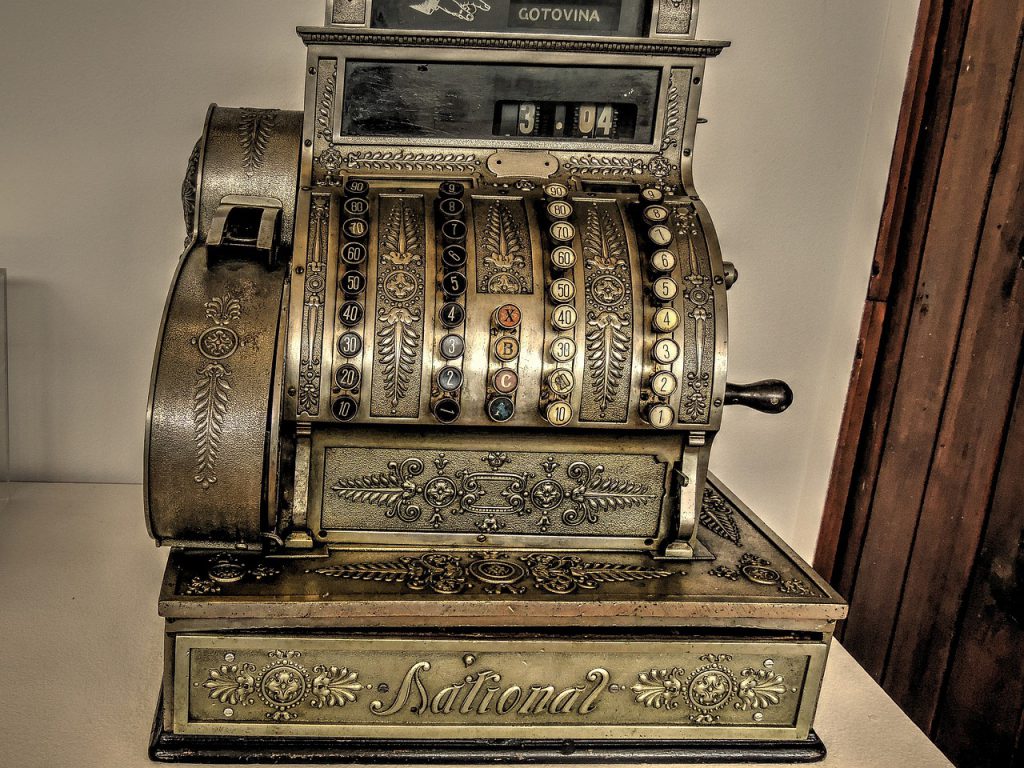
The construction material is a critical aspect when assessing the value of an antique cash register. Not only does high-quality material point to craftsmanship and durability, but it can also bump up its appeal with collectors.
Plus, it reveals a lot: bage, manufacturer, and place of origin, each carrying weight in its worth.
So, you’ll want to examine its materials carefully.
The following materials are commonly found in antique cash registers, each with its characteristics that can influence the antique cash register’s worth.
Brass and Bronze
Many antique cash registers, particularly those from the late 19th and early 20th centuries, were made from brass or bronze. Not only do these materials withstand the test of time, but they also sport an uber-appealing look.
If you’re lucky enough to come across one of those ornate brass or bronze cash registers with embellished detail, you’ve hit the jackpot. These antique cash registers are highly valued for their aesthetic charm and masterful craftsmanship. Their price is usually upwards of $1000, depending on the condition.
The National Cash Register Model 313, a swanky antique gem crafted from brass and bronze during the turn of the 20th century, is the perfect example of classic beauty.
Its rectangular base with curvaceous edges stands tall on four intricate feet, and its front panel boasts a glass window revealing monetary values printed on individual keys. The brass components give it a royal glint, while the bronze adds an alluring subtleness to its hue.
The register’s top is eye-catching, with a flashy brass marquee proudly displaying “Amount Purchased” in flamboyant lettering. Add a generous sprinkle of ornamental filigree on either side, and the classic machine is doused in elegant sophistication. The keypad’s rows of circular brass tops flashing the corresponding denomination bring it all together.
The side panels of the register showcase intricate scrollwork, and the cash drawer, which slides out from the bottom, is also decorated with engraved patterns. A crank handle on the right side of the register is used to operate the cash drawer and record the transaction.
Cast Iron
Cast iron is renowned for its strength and durability, so it’s no wonder it was a popular material used in antique cash registers. These time-honored machines boast eye-catching designs and patterns that make them attractive to collectors.
However, you should inspect the condition of the cast iron, as it’s prone to rusting, which can diminish the cash register’s value.
The Hallwood Cash Register is the perfect antique example of what a cast iron cash register should be, a testament to the late 19th-century industrial aesthetic.
This sturdy and dependable rectangular-shaped beauty features four intricately crafted legs and wonderfully rounded corners, with that iconic cast iron construction offering a sleek, matte finish. It’s undoubtedly one of the best of its era!
Glimpsed through the register’s glass window is an array of keys – shiny brass mounds, each invaluable treasure marking a different amount. Above, the cast iron marquee arches display “Hallwood Cash Register” in bold lettering. The circular-topped keys gleam out from the dark body along the rows of metal beneath.
Beautiful raised, minimalistic patterns decorate the side panels of the register, and a delicate horizontal engraved line adorns its inviting cash drawer at the bottom. On its right side sits a crank handle, enabling users to operate it efficiently and document every transaction.
Cast-iron antique cash registers, like the Hallwood model, usually cost between $1000 and $3000, but their price varies depending on condition and rarity.
Wood
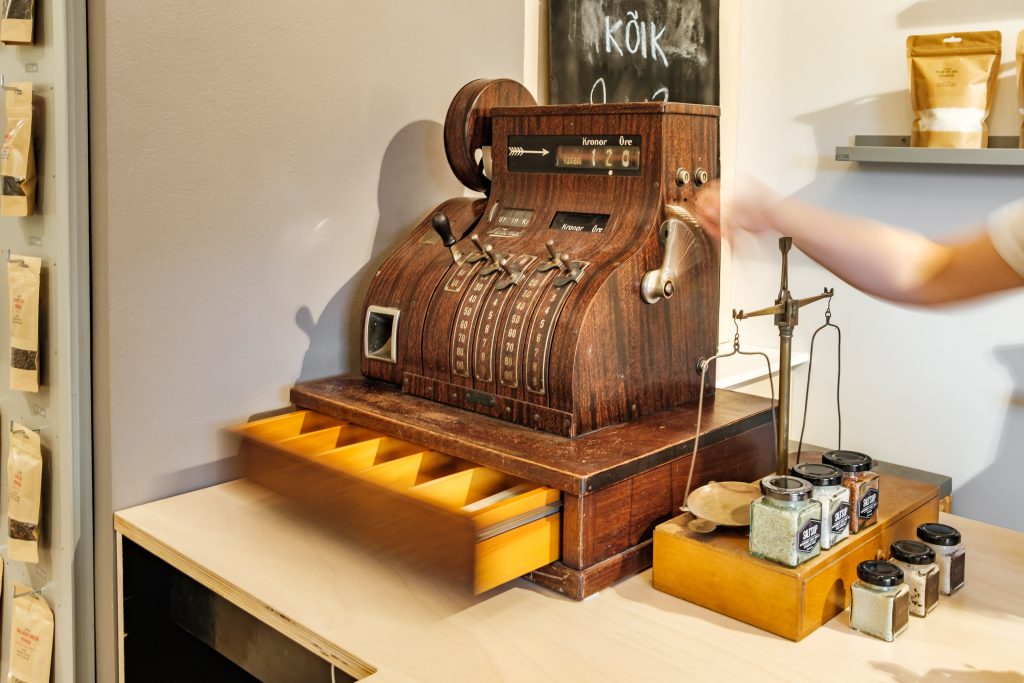
Wooden cash registers, although less common, are an interesting part of the cash register history. Typically, these registers date back to the late 1800s and early 1900s and may have been used in small businesses or rural settings. Wooden cash registers can vary in value depending on the type of wood, craftsmanship, and overall condition.
The “St. Louis Cash Register” vintage wooden cash register from the early 1900s exemplifies that time’s fine craftsmanship. The antique piece in question is both elegant and sophisticated.
This cash register is a luxurious masterpiece, crafted primarily from solid hardwoods like oak or mahogany, giving it a warm and vibrant finish that accentuates the gorgeous wood grain. Its rectangular shape flaunts slightly curved edges and four sturdy wooden feet that are as dependable as they are inconspicuous.
Behind the register’s glass window, you can see those individual keys and monetary denominations. And perched on top of the window is a little wooden sign showcasing “St. Louis Cash Register” in gorgeously carved or painted letters.
The registers’ keypads are set up in lines, each key displaying a circular wooden top – engraved or painted with its denomination. Some even have metal caps with the denominations embossed on!
Intricate carvings or simple raised patterns adorn the register’s side panels, lending a touch of elegance. Out slides its cash drawer, gleaming with detailed woodwork and handles made of brass or iron, which make operation a breeze! An engraved or painted design on the drawer front adds the finishing touch to the regal register.
If you’re lucky, you can find a wooden model, like the St. Louis Cash Register, for $500. Still, those in pristine condition cost a lot more.
Steel and Aluminum
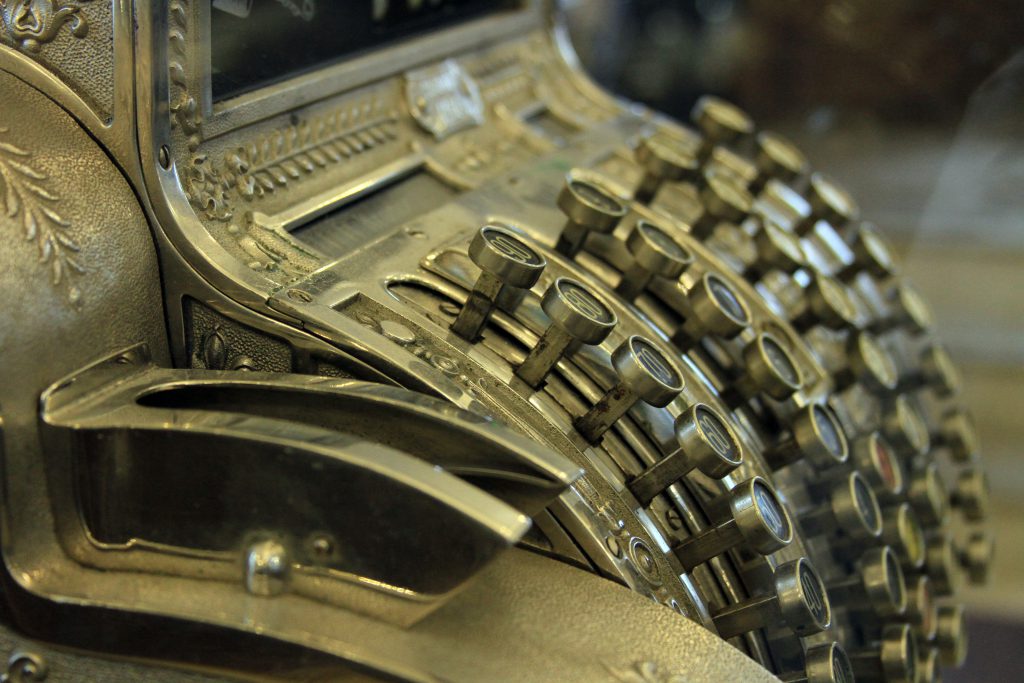
As manufacturing technology advanced, steel and aluminum swiftly became the go-to materials for cash register construction. They were a much more reliable and lightweight choice, so it was no wonder many businesses jumped on board. These antique cash registers aren’t as fancy as the old brass or cast iron ones, but they can still be worth something if they’re rare, well-preserved, or have unique features.
An example of an antique cash register made of steel and aluminum is the Burroughs Adding Machine Company’s “Class 3” cash register, produced in the early 1900s. If you have a cash drawer like this one, you’ll probably be able to sell it for anything between $150 to $700, depending on its condition and rarity.
The Burroughs “Class 3” cash register is a robust and visually appealing piece, exemplifying the combination of functionality and design from its time. The register is primarily built using steel and aluminum, with the steel components presenting a durable finish, while the aluminum parts are polished for an attractive shine.
The rectangular cash register sits sturdily, with four legs providing a reliable base. Showcasing a crystal-clear glass window through which you can make out each key’s monetary denomination, the front panel impresses with its Burroughs Adding Machine Company engraving or logo.
The register’s keypads are lined up in neat rows, each with distinctive round aluminum tops that have denominations engraved or stamped on them. The varying colors help make using the keys a breeze.
Identifying the Construction Material
To determine the construction material of your antique cash register, start by inspecting the machine closely. Scan for any labels or markings that can give you a clue, as they could reveal the material used in its construction.
Check out the register’s weight, heft, and style. Does it have that classic golden brass or bronze hue? Or is it darker with a more substantial cast iron feel? If you’re unsure of its material makeup, contact an antique professional.
Evaluating Material Condition
The condition of the construction materials is vital in judging the worth of an antique cash register, so check it out for signs of aging, corrosion, or damage, which could lessen its look and performance. A bit of patina may add to its value, but too much damage or rust can knock that price tag down.
Material Rarity and Desirability
While some materials may be more desirable to collectors due to their rarity, others can be sought after for their design, like ornate brass and bronze cash registers with intricate detailing.
Understanding the market demand for specific materials and what collectors are looking for pays off when gauging the worth of your antique cash register.
Exterior Decoration
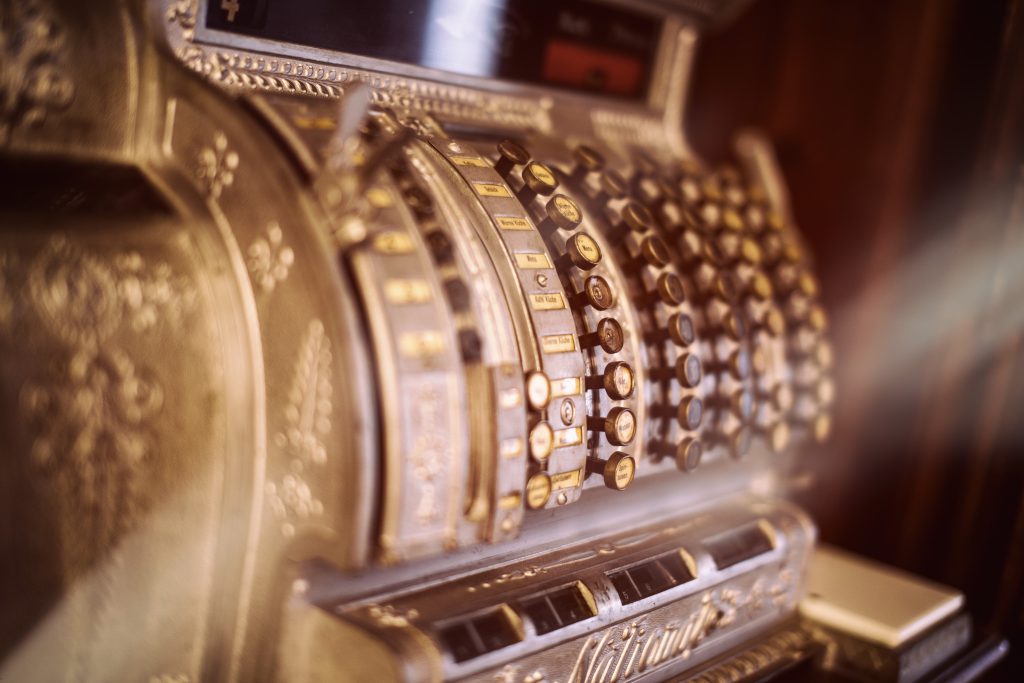
The exterior decoration of an antique cash register also plays a crucial role in its value. Intricate designs, ornate patterns, and unique features can transform a simple cash register into a stunning piece of art.
The decorative elements showcase the craftsmanship and attention to detail of the era when the piece was manufactured, making them highly desirable to collectors.
Various exterior decorations can be found on antique cash registers, each contributing to the item’s overall appeal and value.
Engraved Patterns
Many antique cash registers have stunningly intricate engraved patterns and designs adorning their metal casings. From the modern geometric shapes of one era to the breathtaking floral motifs of another – these masterpieces reflect their period’s artistic vision.
Astonishingly, those with preserved engravings typically carry more value than simple designs or tampered patterns.
An example of an antique cash register with engraved patterns is the National Cash Register (NCR) Model 332, produced in the early 20th century. Its price is usually upwards of $1500.
The NCR Model 332 is a showstopper! Its beautiful brass casing has intricate, ‘flower-power’ engravings reminiscent of the iconic Art Nouveau and Tiffany designs that were all the rage in the late 1800s and early 1900s. Best of all, it comes with a curved glass display window, ornate key arms, and a delicately carved marble ledge.
Ornate Details and Embellishments
Intricate details can make all the difference! Scrollwork, filigree, and raised relief work add value to a register and show off the manufacturer’s expert craftsmanship. Collectors go wild for those with their ornate details still intact.
With a focus on elaborate details and decorations, the National Cash Register (NCR) Model 47, produced in the late 1800s and early 1900s, is an excellent example. It’s renowned for its righteous Victorian style, featuring lavish decorations and mesmerizing cast iron patterns that render it an extraordinary icon of its era.
This artistic creation is adorned with exquisite scrollwork, floral designs, and other lovely embellishments, gilded with a hint of gold or silver. The shiny brass nameplate and delicate engravings highlight the front panel, making the register even more unique. And for the pièce de résistance – there’s a gracious curve on that glass display, stylish key arms, and a polished marble platform to complete its lavish look.
Antique cash registers like the National Cash Register (NCR) Model 47 easily exceed $2000.
Company Logos and Branding
Antique cash registers often prominently feature the manufacturer’s logo or branding on the exterior. Various logo types can be engraved, embossed, or applied using techniques such as decals or enamel. Collectors may be drawn to specific brands or symbols, which affect the value of the cash drawer. Additionally, the overall condition and clarity of the logo can influence the item’s desirability.
Unique Features
Some antique cash registers are eye-catching and have unique features that make them stand out. Think funky shapes, bespoke designs, and even limited edition gems.
And if they’ve got one-of-a-kind finishes or different unique characteristics? Well, you can bet that their rarity will ensure a handsome price tag for those who want to take them home.
An exceptional example of an antique cash register with distinctive features and design is the Hallwood Model 1, crafted in the late 1800s.
The Hallwood Model 1 is truly special; it’s been crafted with an exquisite blend of gorgeous materials and designer details. Showcasing a stunning wooden frame and ornate brass accents along with intricate carvings that possess a heart-stirring hint of nostalgia, this register has so much to offer. But perhaps the most eye-catching aspect is its one-of-a-kind clockwork mechanism – not only does it document sales, but it also rings a bell each time there’s a transaction. No wonder it’s so highly sought-after by collectors and connoisseurs alike!
Functioning Mechanisms

A cash register’s workings are the real deal-breaker regarding its value. If it still rocks and is in pristine condition, then you know it’s crafted to last! Collectors will always vouch for operational registers. There’s nothing quite like the tangible connection to history we get when interacting with something as complex and masterful as a functional old-timey register. It’s no wonder they’re so sought after. Functional cash registers bring out all the remarkable mechanical innovations from back in the day.
Antique cash registers can feature various mechanisms, each impacting the item’s overall value.
Key-driven Mechanisms
Many antique cash registers use a set of keys corresponding to specific amounts. Pressing a key would trigger a mechanical process that displays the transaction amount, opens the cash drawer, and rings a bell. Registers with intact key-driven mechanisms are more valuable than those with missing or non-functional keys.
An example of an antique cash register with key-driven mechanisms is the St. Louis Cash Register Model A, manufactured in the early 20th century.
The St. Louis Model A showcases a key-driven mechanism, an early cash register technology hallmark. Each key on the register corresponds to a designated amount or function. Pressing a key initiates a sequence of gears and levers that record the sale, open the cash drawer, and produce a printed receipt, all in one smooth action.
Crank-operated Mechanisms
Crank-operated cash registers were an early form of mechanical registers that required the user to turn a crank to process transactions. These registers often feature intricate internal gears and mechanisms that showcase the ingenuity of early mechanical engineering. Collectors highly seek a functioning crank-operated register due to its historical significance and mechanical complexity.
A notable instance of an antique cash register equipped with a crank-operated mechanism is the Barber’s Improved Cash Tiller, manufactured in the late 1800s.
The Barber’s Improved Cash Tiller was way ahead of its time with its revolutionary crank-operated system. Buttons were numbered to correspond to the amount the cashier needed to record, and all they had to do was press the right one. When they cranked it up, it would automatically log their transaction, open the drawer, and update the total displayed on a dial.
Electric Mechanisms
As technology progressed, electric cash registers began phasing out their antique mechanical counterparts. While they aren’t relics, they can still fetch a good price if they’re rare, well-preserved, or feature innovative designs. Collectors tend to prefer vintage electric models in working order over non-working ones.
A prime example of an antique cash register featuring electric mechanisms is the National Cash Register (NCR) Class 1000, introduced in the early 1900s.
As one of the earliest electric cash registers ever produced, the NCR Class 1000 represented a significant technological breakthrough.
This sophisticated model was equipped with an electric motor, making its operations smoother and quicker than ever before. All you had to do was plug it into a power source. When customer keys were pressed on the keypad, the electric motor would get the gears and levers into action, opening the cash drawer and generating a customer receipt.
Evaluating the Functioning Mechanism
To assess the condition and functionality of an antique cash register’s mechanism, you may need to perform a hands-on examination. Press the keys or crank a lever to ensure they respond correctly – like opening the cash drawer and ringing the bell.
Look for any wear and tear, chinks, or corrosion inside its gears, springs, or levers that could affect performance. If it’s too challenging to assess alone, get help from an expert appraisal business.
Maker’s Mark and Brand Name
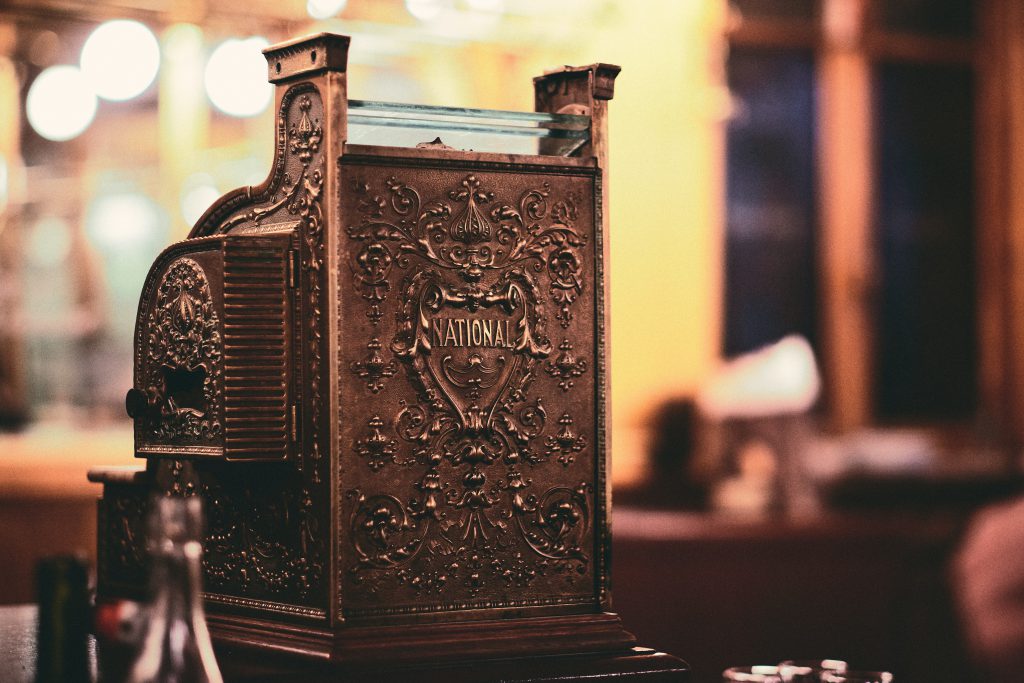
The maker’s mark and brand name are essential in determining the value of an antique cash register. A register’s identifiers can provide valuable information about the register’s manufacturer, which may be associated with specific levels of quality, craftsmanship, or innovation.
Additionally, the maker’s mark can often help pinpoint the manufacturing date, allowing collectors to gauge the register’s age and rarity more accurately.
Several well-known brands and manufacturers produced cash registers during the late 19th and early 20th centuries.
- National Cash Register (NCR)
Founded in 1884, NCR is one of the most famous and highly sought-after cash register brands among collectors. NCR produced various registers, from simple models to highly ornate brass and bronze machines. Identifying an NCR cash register adds significant value, as the brand is synonymous with quality and innovation.
- Hallwood Cash Register Company
The Hallwood Cash Register Company was another prominent manufacturer during the late 19th and early 20th centuries. Although not as well-known as NCR, collectors still highly regard Hallwood registers for their craftsmanship and unique designs. Finding a Hallwood register can be a valuable discovery for collectors.
- American Cash Register Company
American Cash Register Company was a competitor of NCR and produced registers with similar features and designs. While not as highly sought after as NCR registers, American Cash Register Company’s machines still hold value, especially if they are in good condition and feature unique characteristics.
Identifying the Maker’s Mark and Manufacturing Date
Carefully examine the outer and inner surfaces of your vintage cash register to locate its maker’s mark and stamp date. Usually, the maker’s symbol or brand is located on the front, sides, or bottom, while the manufacturing date may be engraved close by or on a distinct label/plate.
Once you’ve located the maker’s mark and manufacturing date, dig online or check out some reference materials. This will help you get the lowdown on what was happening at the company when your cash register was made and where it fits into their product lineup. It’s a great way to put it all in context!
Factors Influencing Value
The maker’s mark and manufacturing date can impact an antique cash register’s value in several ways.
- Brand reputation
Registers produced by well-known and reputable brands, such as NCR, tend to be more valuable than those from lesser-known manufacturers. Collectors often seek out specific brands due to their association with quality, craftsmanship, or innovation.
- Rarity
Registers from specific brands or production periods may be rarer than others, increasing their value. For example, a cash register from a short-lived manufacturer or a limited production run will likely be more valuable due to scarcity.
- Historical significance
Cash registers with maker’s marks or manufacturing dates corresponding to significant events or milestones in the company’s history hold additional value. For instance, a cash register produced during a company’s early years or a period of significant innovation may be more sought after by collectors.
Online Price Comparisons
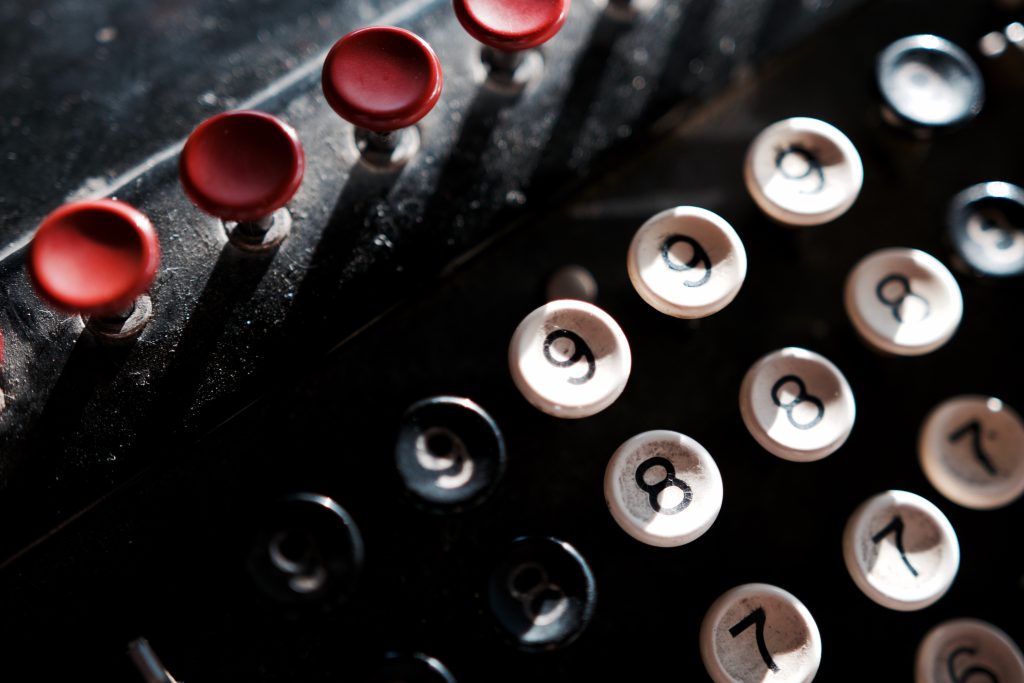
Comparing the prices of similar antique cash registers for sale online provides several advantages.
- Access to a broader market
Online platforms connect sellers and buyers from across the globe, offering a larger sample size for price comparisons.
- Real-time data
Online listings are frequently updated, providing current market trends and pricing information.
- Easy research
The internet allows collectors to search for and compare multiple listings quickly and efficiently.
Steps for Comparing Prices on Online Platforms
First, make an inventory of what’s available online. Log onto different platforms and check out what they have to offer. Then, get down to brass tacks – it’s time for comparison shopping.
Don’t forget little details that could affect the price, such as condition, age, or special features.
Finally, trust your gut. If one bargain seems too good to be true, it probably is! Oh, and don’t set your heart on just one item. Browse different options, so you won’t feel stuck for choice when one item goes up in price.
Before you start shopping around, take note of your cash register’s key characteristics, like brand, model, age, and material. Plus, its build and working mechanisms – even its decorated exterior! Doing this will help you compare prices on similar registers with precision.
Start your search for the perfect antique cash register by perusing popular platforms like eBay or Etsy. With a vast selection of vintage cash registers, you can view the various listings to get an idea of the going rate.
Remember, as with anything vintage, the price may vary depending on variables such as seller reputation and location, not to mention shipping charges.
As you rifle through the listings and make a price comparison, whip up an Excel sheet or document to track what you dig up. That way, not only can you stay organized but spot any trends in the market as well.
Interpreting Price Comparison Results
So you’ve compared prices of similar antiques, and now it’s time to decide how much your cash register could be worth. Check out the data you gathered, and see what the average price of the listings most closely matches your cash drawer.
Keep in mind that some prices may be higher or lower depending on things like rarity, condition, and location. Check what factors most notably inflate (deflate) the price, and see if your antique cash registry has them.
How does your cash register stack up to the ones you’ve looked into? Put it in its price range depending on its features. Say, if your register is in better shape than the others you checked out, it could be worth more than most in that same range.
If your antique cash register has any special features, design elements, or historical significance that aren’t reflected in the compared listings, increase its value. Also, if that’s the case, you’d be wise to get an expert opinion for further guidance.
Caveats and Limitations
While online price comparisons can provide valuable insights into the value of antique cash registers, it’s essential to consider the following limitations.
- Inconsistent pricing
Online platforms may feature listings with a wide range of asking prices, reflecting different seller expectations and insufficient market knowledge. Exercise caution when interpreting pricing data and focus on completed sales or reputable sellers to obtain more accurate information.
- Subjective factors
Value can be influenced by subjective factors, such as personal taste and collecting trends. It’s essential to remain flexible and understand that the perceived value of an antique cash register may fluctuate over time.
Complementing Price Comparisons with Expert Appraisals
Online price comparisons can be an excellent place to start when evaluating the value of an antique cash register, but why not take it up a notch and consult with an authority in the field?
After all, if you want a comprehensive estimation of your treasure trove, experienced appraisers or specialists in cash register collecting can give you much better insight.
Professionals can evaluate your cash register’s condition, rarity, and significance in history, including subtle factors you’d probably overlook if you only depended on internet research. So, by combining online price comparisons with an expert value assessment, you can gain a more genuine appreciation of that vintage machine’s worth.
Staying Informed about the Market
Staying in the know about antiques, such as cash registers, is critical for savvy buyers since their value can shift and sway with current market trends and collector cravings. By keeping tabs on everything from online outlets to collector conversations and antique auctions/shows, you’ll get an inside look into how the market behaves, giving you a leg up when gauging the worth of your sweet cash register.
Conclusion
In sum, figuring out how much your antique cash register is worth can be a super fulfilling adventure where you gain an even deeper respect for its historical and artistic importance. Think about the material it was made with, the exterior designs, its functioning parts, and who made it – all these elements make up what collectors will pay for it. So go ahead and get to know your collectible piece better!
Don’t forget getting experts’ opinions and doing your due diligence is essential in making a wise choice about your beloved antique. Whether you keep it as a treasured family relic or sell it to another collector, finding its value will add even more sentimental value to this incredible part of history.

Leave a Reply